Colostrum MAF
Oral Colostrum MAF 60 Capsules
Contains 60 x 1 mg Oral Colostrum-MAF™ in enterically coated (acid-resistant) capsules. The enteric coating permits transit through the stomach and dissolution in the small intestine.
Each capsule contains
- 1 mg Colostrum-MAF™
- Equivalent to 100 ng of Macrophage Activating Factor (GcMAF)
- Immunoglobulins and other immune factors
Oral administration
Take with water: 1 capsule daily on an empty stomach (30 minutes before or 2 hours after meals).
Sublingual administration
Use sublingually by opening the capsule and gradually dissolving in the mouth. Allow about 5-10 minutes to absorb the GcMAF in the mucosa of the mouth. Avoid eating or drinking soon after, to continue absorbing the GcMAF for longer in the throat.
- For maximum effect, take one capsule orally with water after rising in the morning followed by one capsule sublingually.
- Capsules may be taken orally and sublingually at other times of the day or around bedtime each day.
- For higher doses, take capsules orally and sublingually 2-4 times daily.
- Take a daily oral vitamin D3 supplement, 5000 IU or a dose high enough to achieve a blood level of between 70-100 ng/ml (175-250 nmol/l) during treatment. After treatment, maintain a level of 50-70 ng/ml (125-175 nmol/l). For better absorption, Vitamin D should be taken with a fat-containing meal.
Topical administration
May also be used as an aid to unblemished skin.
- Rub contents of capsule onto skin with moisture as required.
- Leave in place for up to 30 minutes.
- Wash off with lukewarm water.
Storage
Store bottles well sealed and refrigerated or in a cool dry place to maintain the maximum efficacy of Colostrum MAF™. The product will remain fully effective for one year or longer when refrigerated.
Transport
During regular use, bottles may be kept at room temperature without refrigeration.
Long-term storage
Benefits from refrigeration.
DOES NOT contain
Artificial colours, flavours, preservatives, sugar, gluten, soy, wheat, egg, rice, starch, hormones, antibiotics.
Details
Immune power is increased with food made from colostrum which is rich in immunological ingredients.
Supplements of future colored supplements including colostrum MAF are introduced on this page.
Immune Colostrum and Colostrum MAF
What is colostrum?
Colostrum is a very valuable form of yellowish milk and secreted only for a few days after parturition. Colostrum contains numerous immune sub-stances and protects the newborn from bacteria, viruses and various diseases.
Immune Components in Colostrum

Bovine colostrum is rich in immunoglobulin of immune components IgG, IgA, IgM. In addition to the immune components, lactoferrin, minerals and vitamins are also present in abundance.
Report of Study on Bovine Colostrum
Research on cattle colostrum is proceeding. The following report discusses the effect on humans.
- Improved Immunity
- Prevention of colds and influenza, prevention of infectious diseases such as rotavirus
- Intestinal repair action
- Enhancement of muscular strength and strength
- Anti-aging effect
Cattle Colostrum as MAF Food
- Food manufactured from bovine colostrum in powder form
- In terms of components, colostrum is very similar to blood
- It can be licked like an ice cream cone or taken in the form of enteric capsules
- Activates macrophages and boost immunity
Colostrum and Anti-Aging – What is the Immune Age?
Immunity is a system for keeping all living things of a body healthy. This immune system protects the body from bacteria and viruses, and eliminates cancer cells. The peak of human immunity is at age 20. At age 40 years, immunity decreases to one half, immune power goes down, and the body becomes prone more easily to various diseases.
Therefore, to conserve the immunity of the young is considered a necessary pre-condition for a long and healthy life. This is now becoming a real possibility.
How Macrophages (Phagocytes) Work
1. Function of NK Cells
An NK cell is a cell that phagocytizes and digests cancer cells, viruses and bacteria.
Macrophages differ from monocytes (mononuclear leukocytes) which account for 5% of white blood cells in the blood. They are ameboid-like cells in the center of immune cells and digests invading bacteria and viruses as well as foreign substances (cancer cells) in vivo.
In the past, macrophages came in two different types, M1 macrophages that activate immunity and
M2 macrophages that suppress immunity. However, recently it is thought that in addition to classical activated macrophages, wound-healing macrophages, suppressive macrophages or intermediate activation states also exist. The diversity of macrophage activation is not yet fully understood.
About the important function of this activated macrophage, cases of a complete cure from AIDS, breast cancer, colon cancer or prostate cancer have been reported, and there is a possibility that the evaluation and recognition of activated macrophages will have to be fully revised.
The process of activating macrophages to kill cancer cells is as follows:
- Activated macrophages bind directly to cancer cells
- Activated macrophages liberate and release chemical substances (e.g. hydrogen peroxide) to exterminate cancer cells
2. Function of Dendritic Cells
Antigen presentation of phagocytosed cancer cells, viruses and bacteria is performed on helper T cells and B lymphocytes. I.e., it acts as a dendritic cell.
Upon ingestion of antigens, macrophages release various cytokines and activate specific T cells. Macrophages make foreign fragments that have been taken up and decomposed by phagocytosis into fragments and bind them to the class II MHC (MHC-II) originally contained in the cells to express them on the cell surface. This is called antigen presentation by macrophage.


Macrophages (purple) are eating cancer cells
3. Angiogenesis Inhibitory Aaction
Animal experiments have confirmed that GcMAF (Zisiomuff) has an inhibitory effect on cancer angiogenesis.
The Process of Phagocytosis by Macrophage, Image Wikipedia
- The phagocytized foreign matter is taken into the phagosome (phagosome)
- Vesicles fuse with lysosomes to form phagolysosomes, foreign bodies are destroyed by enzymes
- The residue is excreted (or digested) extracellularly
- 1. Foreign body (pathogen), 2. Phlegm, 3. Lysosome, 4. Residue, 5. Cytoplasm,
- Cell membrane
- The signal of antigen presentation by macrophages is transmitted to lymphocytes called helper T cells among T cells. On the surface of the helper T cells, surface proteins unique to helper T cells called CD4 and receptor proteins called T cell receptor (TCR, T-cell receptor) are present. MHC-II of macrophages and Helper T cells are activated by binding with the antigen presented by macrophages. The structure of the T cell receptor differs from one helper T cell to another and only helper T cells with receptor that fit exactly the antigen fragment presented by macrophage are activated.
Activated helper T cells activate macrophages by producing hormone-like substances (cytokines) such as interleukin and lymphokines and activate B cells that recognize the same antigen that they recognize. Activated B cells will differentiate into antibody-producing cells, proliferate, and produce and release antibodies corresponding to the antigen. Antibody specifically binds to antigen and the antibody-antigen complex. Macrophages are attracted to this antibody-antigen complex and phagocytize this complex. Antibody-bound bacteria and viruses are consumed very efficiently by macrophages. At this time, T cells activate macrophages by releasing lymphokines, etc., and help the proliferation and differentiation of B cells.
Therefore, macrophage activation therapy is a therapy that maximizes activation of the immune system originally provided to humans.
NK cell therapy plus dendritic cell therapy are assumed to be a cure that combines the functions of either.
What is GcMAF?
Researchers involved in GcMAF Research and Development
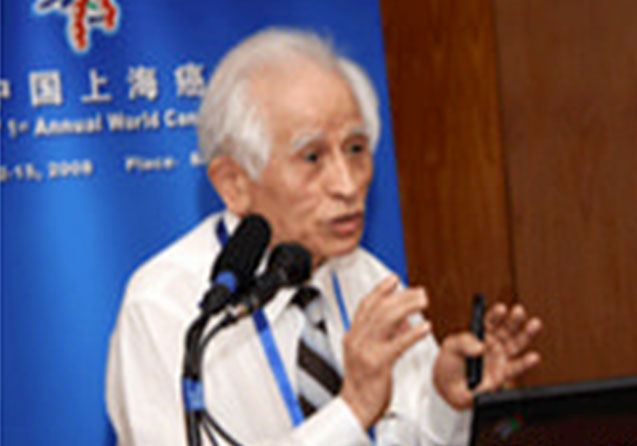
Prof Yamamoto Nobuto has developed the center of GcMAF research in the past 20 years.
History of GcMAF Development
1991
Prof Nobuhito Yamamoto discovers GcMAF
1992
Following a visit to Dr Horimanima, Prof Nobuhito Yamamoto starts the research of GcMAF at the University of Tokushima
1998
Mr Yoshihiro Utsuno enters the research team
2002
The first research paper is published (first-generation GcMAF)
2010
The University of Tokushima and the revitalization future starts joint research and development of second-generation GcMAF
2011
Production of second-generation GcMAF for clinical use at the future cell culture center and start of clinical research
2012
20 years have passed since GcMAF research started at the University of Tokoshima
2013
Two papers published in Anticancer Research, the results of joint research and development by the University of Tokushima
2013
In the regenerative future, second-generation GcMAF applied cases exceed 1000
2014
Three papers published in Anticancer Research
2015
The University of Tokushima and the future of regeneration succeeded in adapting GcMAF cattle colostrum as a world first
Subtypes Due to Differences in the Sugar Chain Structure of GcMAF
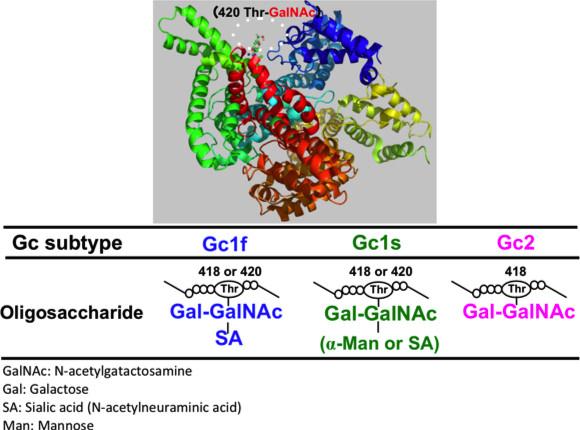
The Gc subtype has three genotypes, Gc1f, Gc1s, and Gc2. As its phenotype, since it is a dimer of homo- and heterozygotes, there are six types altogether, i.e. Gc1f1f, Gc1s1s, Gc22, Gc1f1s, Gc1f2, Gc1s2.
Conversion of Gc Protein to GcMAF

N. Yamamoto, et al., J. Immunol., 151, 2794 – 2802, 1993.
The Gc protein undergoes sugar chain splitting by ?-galactosidase from activated B cells and sialidase from T cells and is converted to GcMAF as per the famous theory published by Dr Yamamoto.
Physiological Activity of GcMAF
The physiological Action of GcMAF is:
- Increase in ability to activate phagocytosis
- Increase in superoxide production
- Inhibition of angiogenesis
- Promotion of antitumor activity
- Increase in the number of monocytes in the blood
- Promotion of dendritic cell maturation.
These six types are particularly important. Increases in mononuclear numbers in the blood, promotion of maturation of dendritic cells, etc. have not been reported so far.
Antitumor Activity Test of First-Generation GcMAF
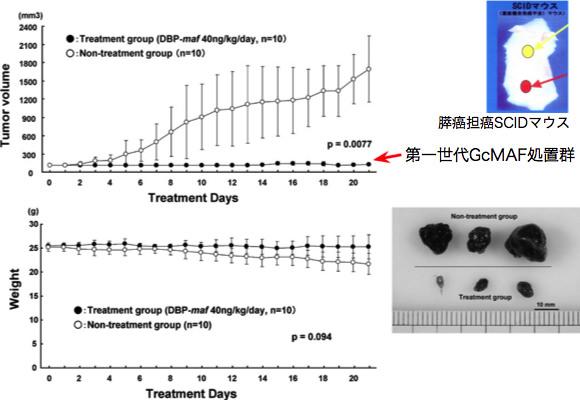
Nonaka K., Onizuka S., Uto Y., et al., J. Surgical Res., 172, 116 – 22, 2012.
Antitumor activity test of first generation GcMAF which uses mice for the experiment. The group treated with first-generation GcMAF has a stronger tumor-suppressing effect than the untreated group. As shown in the figure, the tumor does not increase in size.
Antitumor Activity Test of Second-Generation GcMAF
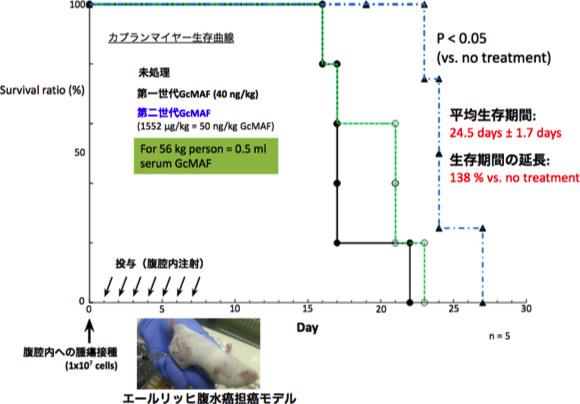
Kuchiike D., Uto Y., et al., Anticancer Res., 33, 2881-5, 2013. Uto Y., et al., PCT / JP2012 / 072884
Anti-tumor activity test of second-generation GcMAF. This is also an experiment using a mouse. The black line is a group without treatment, the dotted green line is a group treated with first-generation GcMAF. The dotted blue line is the group treated with second-generation GcMAF.
Clearly the group treated with second-generation GcMAF has prominent survival extension as compared to the group without treatment, i.e. the group treated with first-generation GcMAF.
Comparison of Ingredients of Colostrum and Serum
| Colostrum | Serum | |||||||
|---|---|---|---|---|---|---|---|---|
| Units | Range | [1] | [2] | [3] | [1] | [2] | [3] | |
| TP | G / dl | 6.5 - 8. 2 | 6.5 | 4.5 | 4.1 | 6.2 | 5.8 | 6.2 |
| Alb | G / dl | 3.7 - 5.5 | 2 | 1.4 | 0.6 | 3.8 | 3.7 | Four |
| A / G | 1.55 - 2.55 | 0.44 | 0.45 | 0.17 | 1.64 | 1.97 | 1.96 | |
| Alb | % | 60.8 - 71.8 | 62.1 | 66.3 | 66.2 | |||
| Uric acid (UA) | Mg / dl | 0 | 0 | 0.3 | ||||
| Alpha1 | % | 1.7 - 2.9 | 3 | 3.6 | 3.4 | |||
| Alpha 2 | % | 5.7 - 9.5 | 9.3 | 9.1 | 7.4 | |||
| Beta | % | 7.2 - 11.1 | 8.9 | 8.5 | 10.2 | |||
| Gamma | % | 10.2 - 20.4 | 16.7 | 12.5 | 12.8 | |||
| IgG | Mg / dl | 820 - 1740 | 871 | 456 | 924 | 1139 | 907 | 1019 |
| IgA | Mg / dl | 90 - 400 | 42 | 36 | 132 | 281 | 171 | 97 |
| IgM | Mg / dl | 31 - 200 | 27 | twenty one | 259 | 115 | 136 | 62 |
As is well known, the first post-partal milky secretion from the breast of nursing women or cows is called colostrum which consists of concentrated antibodies. However, after only 24 hours, the ingredients change rapidly and approach ordinary milk.
Intestinal-Related lymphoid tissue

Intestine-associated lymphoid tissue, GALT is said to be the largest macrophage pool in the body. Peyer’s Patch is known to have abundant macrophages. Colostrum MAF aims to directly activate this tremendous number of macrophages. Dr Utsunomi of the University of Tokushima undertook a basic experiment using MAF and GALT colostrum.
Ability to Activate Phagocytosis by Colostrum MAF
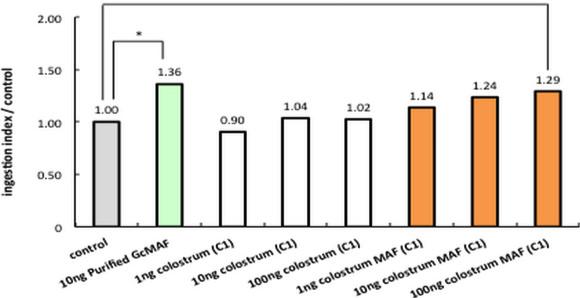
100 ng of colostrum MAF shows almost the same activity as 10 ng of first-generation GcMAF. Patent pending: Japanese Patent Application No. 2013-257888
Activation ability of phagocytosis by colostrum MAF. 100 ng of colostrum MAF shows nearly the same activity as 10 ng of first-generation GcMAF. Therefore, if we use ten times the colostrum MAF, we believe it will have nearly the same effect as the first-generation GcMAF.
Colostrum MAF is scheduled for one capsule of 200 ng. Taking one capsule a day is likely to have practically the same effect as second-generation GcMAF but an examination on this point is still outstanding. It is of course also possible to produce a 1500 ng capsule.
Lymphatic System and GcMAF
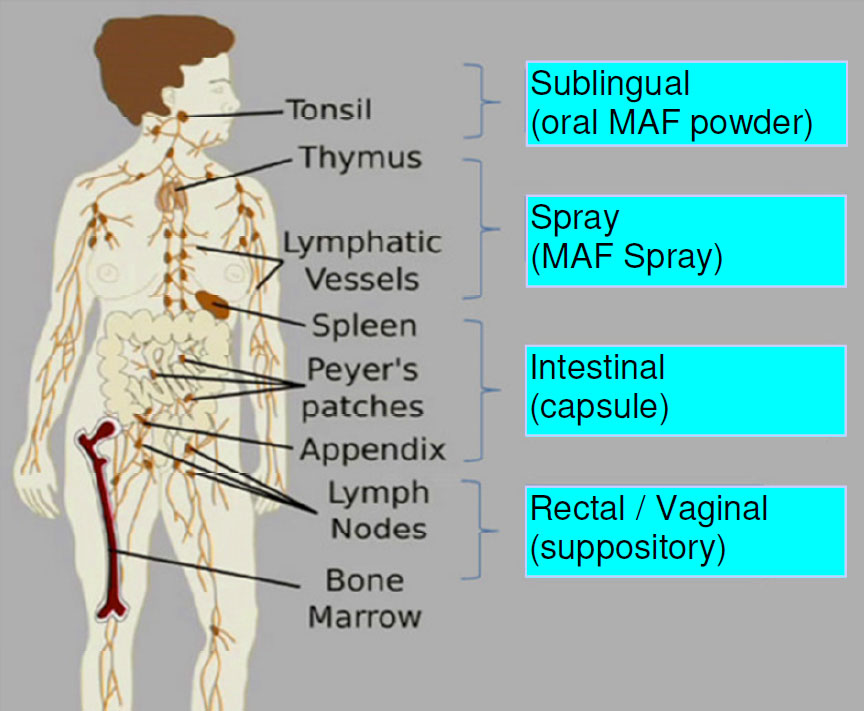
Directly stimulation of lymphoid tissues and macrophage activation near lesions
We are considering administration of sublingual (troche),· inhalation (nebulizer) ·intestinal (enteric capsule)· rectal, vaginal (suppository). ·Directly stimulate lymphoid tissues near the lesion and activate macrophages. It seems that this person is healthier. Regarding inhalation, I heard that the Swiss clinic uses blood-made GcMAF for inhalation. They are probably using an ultrasonic nebulizer.
If so, basic experiments such as whether the structure of GcMAF is changed by the ultrasonic nebulizer are still necessary.
Product and Test
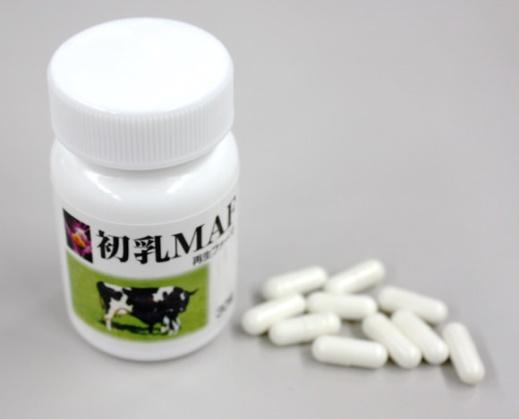
A jar of Colostrum MAF
Macrophage Phagocytosis Activity Test

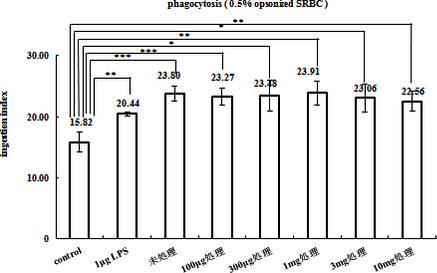
We will a conduct macrophage phagocytosis activity test. This test evaluates the function of major macrophages.
Adaptive Case of Colostrum MAF
- Cancer
- Autism
- Chronic fatigue syndrome (CFS)
- Lyme disease
- Infectious diseases
- Influenza
- Norovirus
- Malaria
- Dengue fever
- HIV
- Hepatitis (Types B and C)
- Tuberculosis
- Autoimmune diseases
- Alopecia
- Atopic dermatitis etc.
How to Take
One capsule each in the morning and before retiring, i.e. two a day.














